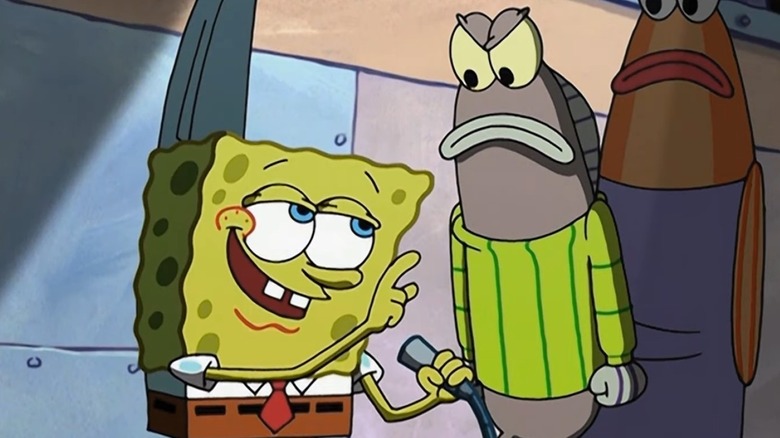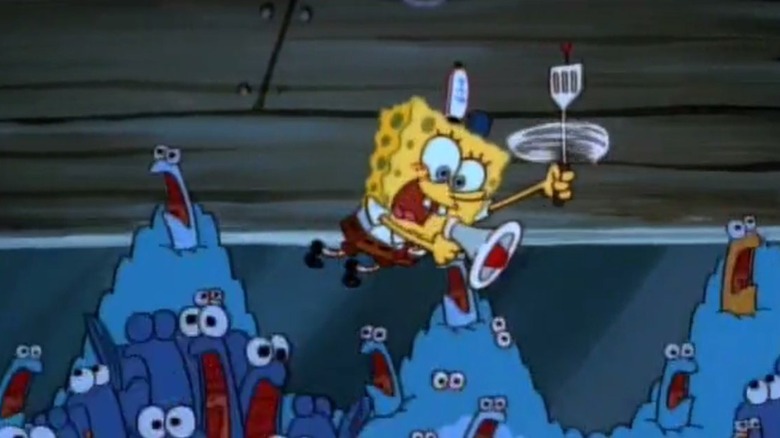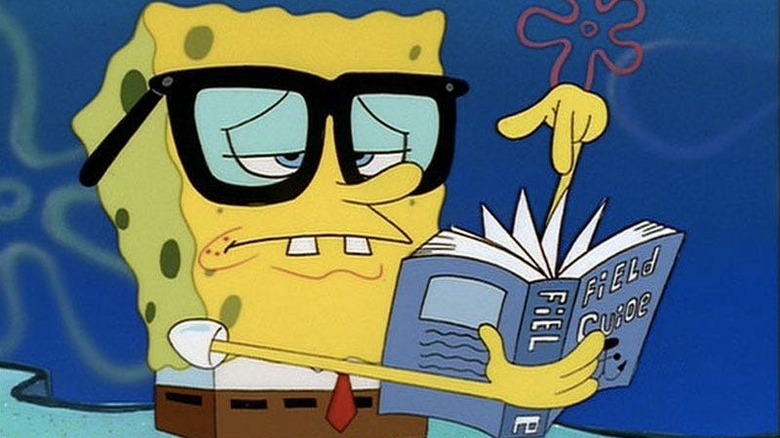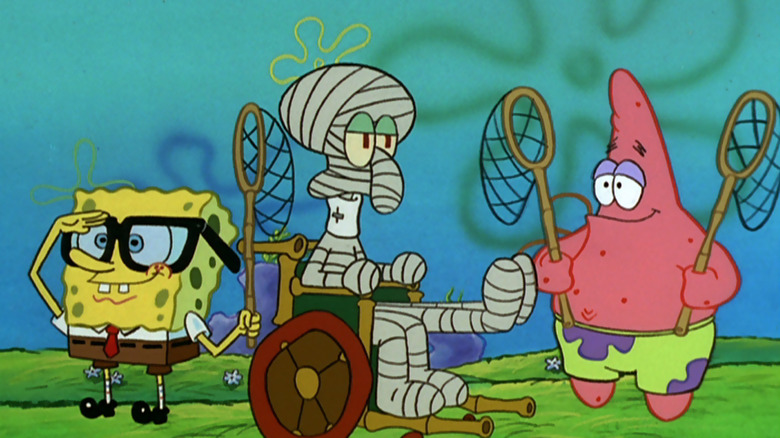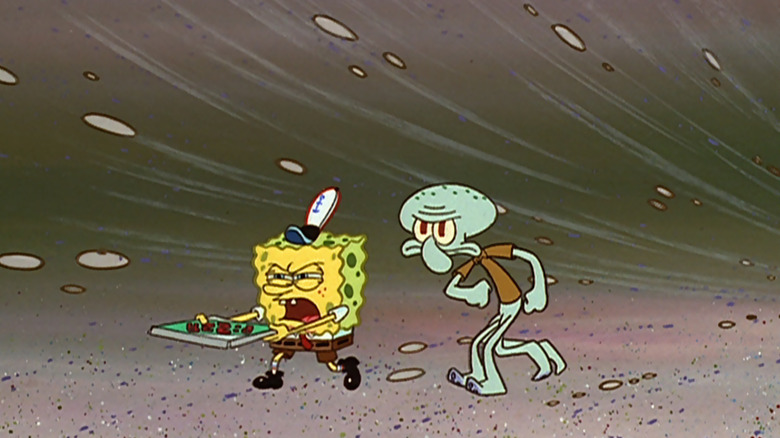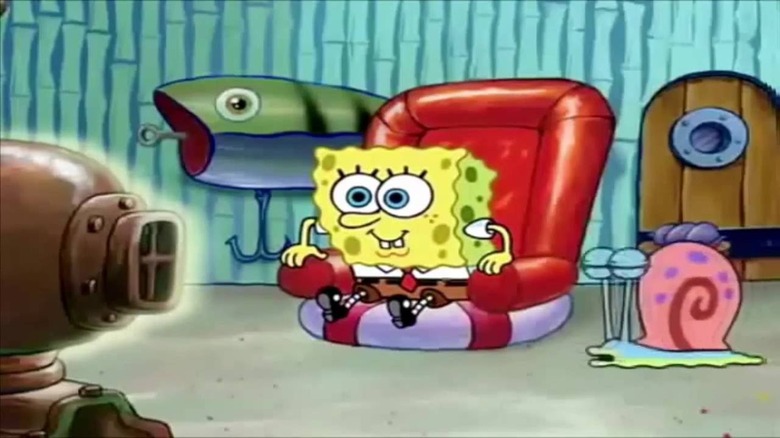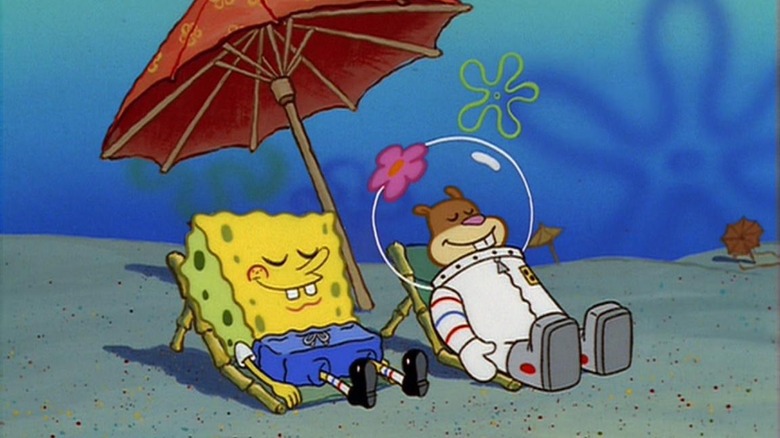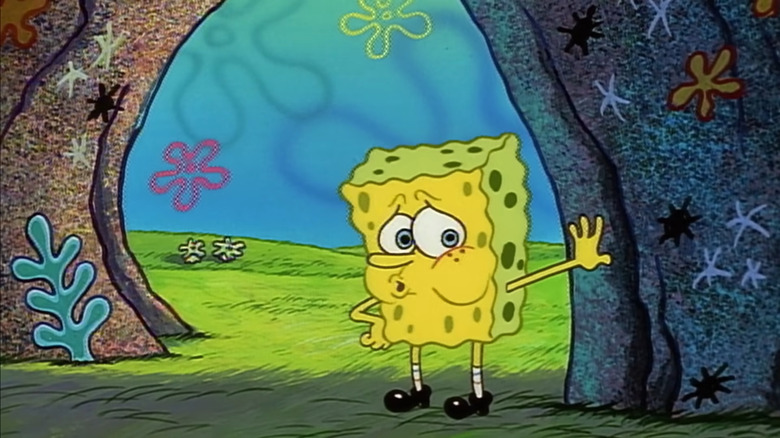SpongeBob SquarePants At 25: The Stellar Voice Cast Share Memories From The Iconic Series [Exclusive]
On July 17, 1999, a little animated show created by an animator and marine biology educator debuted, and it changed Nickelodeon, TV animation, and pop culture forever. "SpongeBob SquarePants," which follows its titular sentient sea sponge living in the underwater city known as Bikini Bottom and working as a fry cook at a popular burger joint, quickly took the world by storm. It overtook "Pokémon" as the highest-rated children's show on television (at the height of Pokémania), and it reinvented Nickelodeon, solidifying the network as the home of the biggest all-ages animated TV shows.
A big part of the show's success is its visual storytelling. The episodes are full of visual gags and an eye for physical comedy that's reminiscent of Golden Age of Animation cartoons like "Merrie Melodies," there's a wealth of sharp scripts with smart jokes, and the show has a terrific ensemble cast of memorable characters and enough background characters to rival the citizens of Springfield. Over the years, SpongeBob has become a symbol of revolution, a Super Bowl halftime show-playing musician and host, a fashion icon, and much more. It's no wonder celebrities from Keanu Reeves and David Hasselhoff to Pat Morita and David Bowie all wanted to join the cast at some point.
The core characters of "SpongeBob" are not just fantastically written, but they're brought to life by one of the best voice casts in all of animation. Tom Kenny, Bill Fagerbakke, Rodger Bumpass, Clancy Brown, and Carolyn Lawrence helped make SpongeBob, Patrick Star, Squidward, Mr. Krabs, and Sandy Cheeks truly iconic characters.
With the show celebrating its 25th anniversary today, I spoke to the main cast to tell the tale of how the cast of "SpongeBob SquarePants" came together.
Note: These interviews have been lightly edited for clarity and brevity.
The SpongeBob cast didn't think there was anything special about their auditions
After working as an animator on the popular Nickelodeon cartoon "Rocko's Modern Life," Stephen Hillenburg sought to create his own animated series, inspired by his experience teaching children about marine animals at the Orange County Marine Institute. During a previous oral history with Hogan's Alley, casting supervisor Jennie Monica Hammond recalled that casting "SpongeBob" was a lot less difficult than other cartoons. For the soon-to-be stars of the show, auditioning for career-defining roles started out as mundanely as any other gig.
Tom Kenny (SpongeBob): I did audition, but Steve already had me in mind from before he pitched it to Nickelodeon, so that was fortunate for me. I didn't really have to jump through any of those hoops and go, "second call, third call, it's down to you and three other guys. You've got to go to producers," all that, "got to go to the network," whatever.
Steve just had so many boxes that he had to check to get this pilot going that he was just like, "Great. I got SpongeBob. Moving on. That's done." And then he started casting everybody else. So I was like just this thing that he got out of the way pretty quickly so he could move on to more important things.
Bill Fagerbakke (Patrick): Tom was in on the ground floor, which was really great for me because [Steve] played a recording of Tom doing "Sponge Boy," as he was called at the time. So I got to hear Tom doing it, and then he said, "So Patrick is his friend, so he needs to balance him out." And fortunately for me, that was in my wheelhouse.
Rodger Bumpass (Squidward): I wish I had this wonderful story. But I tell people, this was just another audition. This was just, back then in the '90s, you would physically go to your agent's office and pick up the copy and go into their little booth and record it and then just walk away, and that's all it was.
Carolyn Lawrence (Sandy Cheeks): I was the anomaly, in that I had run into a casting director on a sidewalk here in Los Feliz with a friend of mine, Quinton Flynn, who's also an incredibly talented voiceover artist. And we were chit-chatting and [the casting director] had asked me if I was a voiceover actress, and she asked me if I had an agent, and that happens all the time in L.A. and it's always a bunch of malarkey. And I just was like, "Yeah, whatever." But she was the one that called me in to audition for "SpongeBob." So it was one of those completely random sidewalk moments. I knew nothing about it.
Clancy Brown (Mr. Krabs): I had just started doing voiceovers. I'd been doing it for a few years, and I was just learning how to do it. My agent at the time, who's now my manager, said, "You've got to show up to these auditions, you've got to do them," and so on and so forth. And I was doing a few action shows like "Mortal Kombat," which is kind of hilariously bad now, looking back on it, but it was fun. It was a good place to learn. And so he sent me this thing and he said, "Just go in there and do a voice." And I said, "Well, it's not really my thing." I mean, I'm used to being directed. I'm used to doing other things.
The voice of Patrick Star did not understand the show at first
Most voiceover auditions are based on a one-sheet, essentially an elevator pitch with the most basic information about a character, without much in terms of nuance. This means that the initial image an actor has of the role, or the show at large, can be vastly different from the finished product.
Bumpass: They usually give you, in a cartoon audition, a drawing of the character, and then they'll describe in words his traits. Our job is to fabricate those into something that is acceptable. And I saw that he had this big honking nose, so I gave him a little bit of a nasal quality. I knew he was sarcastic, so I said, "Oh, puh-lease," kind of thing.
It just fortunately worked out that Steve said that was what we're looking for. As we went on, we came up with his laugh. Steve came to me and said, "They have a gag in mind. Whenever he laughs, they do an accordion effect on the nose." The laugh had to be a rhythmic staccato kind of thing. I always end off-key if I can. And Steve said, "That's it," and walked away. And that's what we settled on. That was part of the process.
Lawrence: She's a squirrel. She's from Texas, she's a scientist. She knows karate. That's it. And then a little bit of dialogue, right? So I did some research to try to figure out the accent and how I wanted her to be, and what all that would look like. Then I just recorded it and you send it in. You don't meet anyone, you just record and it goes off into the universe, and you hope for the best. And then I got a couple of callbacks, and I was like, "Oh, huh, I must've done something." I got to meet the creator, Steve Hillenburg, at the final callback, and I was so nervous. I was such a disaster. I was truly like — I was a train wreck. But yeah, I wound up getting the job. I didn't really have any information. I know Tom had been working with Steve, and he knew so much about the world and the story and everything, and I came into it kind of blind.
I was really excited that she was so complex as a female character. I mean, honestly, personally, I was like, "Wow, this is cool. Here's a capable girl. She can do it all. She's girly, but not crazy girly. She's athletic, she's sporty, she's smart, she's funny." She was so well-rounded that I was just really excited to get to play with her, you know? And I think my initial thoughts were, I was just so overwhelmed. But as the series has gone on, I realized just how important truly that has been to little girls, not just selfish me playing her, but to the girls watching.
Brown: I said [to my agent], "What's the character?" And the character was a stingy crab, at the bottom of the sea. And they sent me the script, and it made no sense to me at all. But that didn't matter. It didn't matter that it didn't make sense. So I said, "Well, this looks crazy enough." I like crazy stuff. I did "Buckaroo Banzai," I can get behind that. So I sort of tried to remember the voice of [Robert Newton] from "Treasure Island," the Disney movie, which is very pirate-y sort of exact prototype for "Arr," and that kind of a pirate thing. So I said, "Okay, I'll go in there and do that kind of weird accent," get the voice like that. And I went in and I sat down with Steve [Hillenburg] in a conference room, and he had a handheld tape recorder.
If you listen to [the voice], it does slowly change. And I credit Steve with that, because being in the room and sort of guiding me through it, I could make the noise and say the words, but he moved me off of that kind of weird accent, that weird pirate-y "Arr." He moved me off of that a little bit. It'll sneak in every now and then, just for comedy's sake. But he refined that for me over the season. Not on that day, but over the season. I remember trying things and doing things and making suggestions. What I mostly remember is Stephen very sweetly and softly saying, "No, Clancy, no, don't do it like that." That's what I remember him doing. Not a lot of affirmation the other way. His affirmation was moving on, and if he smiled and laughed, that was his affirmation. But yeah, he sort of refined it off of my poor imitation of [Robert Newton].
Kenny: Before [Stephen Hillenburg] even pitched it to Nickelodeon, he said, "I have this thing. My first place I pitch it to is going to be Nickelodeon, and then I don't know where I'm going to go after that if they don't bite," which fortunately they did. But he showed me everything. He had the whole world mapped out graphically and character-wise in terms of writing about what their personalities were going to be and also very evocative artwork showing what their personalities were and the houses they lived in and what the town looked like and those flowers that are in the background on the screen and all that. That was all there on paper before. Mostly paper, and there's some watercolor paintings too, but it was all there.
So when he showed me that, I had a really great idea because he was so clear and it was so all there. It was everything I needed to know and I just fell in love with it. Right from the first time I saw it, I fell in love with it. And I always say it's one of the rare times where ... as an actor, you're auditioning all the time. Most of the time you don't get it and you move on. You go to your next audition. "Oh, that would've been nice. I think I would've been good for that, but apparently they didn't agree," whatever. But SpongeBob was maybe one of only a couple of times in my career where I looked at it and I said, "If I turn on the TV and anyone other than me is doing this character, I'm going to be sad. It's going to make me sad. It's going to make me really deeply sorrowful."
As far as finding the voice, Steve knew what he wanted. He just kind of directed me into it. He had heard me do this sort of adenoidal nasal voice before, but never for a major character. And he filed it away and years later he was like, "Remember that thing that you did that one time where you were being that guy?" And I was like, "Not really." And then he pulled up the episode and showed it to me, and he was like, "That guy." And I'm like, "Oh, okay. Yeah, okay. Yeah, okay."
Fagerbakke: I knew nothing. I had no idea. I didn't get it. I didn't get what Steve was trying to do. I had no idea. I thought it was just dopey preschool stuff and that it was stupid. It wasn't until I saw the pilot that the bomb blew my brain apart.
The SpongeBob cast recorded not with scripts, but with storyboards
From the very beginning, one thing that set "SpongeBob" apart from other contemporary cartoons was that creator Stephen Hillenburg decided he wanted the show to be driven by storyboards rather than scripts — an approach that harkened back to the Golden Age of Animation. This meant that the story, the direction, and even the dialogue revolved around visual gags rather than written word, but it also meant that actors had an idea of what the episodes would look like long before the animation came in.
Bumpass: This situation was a first for me and all the cartoons I've ever done. The actors were actually given the storyboards. And these were big, thick tomes of stuff with all the different shots and drawings and stuff on it. It really gave us insight into what the gag is, what the level of energy for that particular gag is. So as we walked into the recording session, we had much more information and it made the process a great deal smoother.
In fact, I saved ... a lot of the actors have saved all of our paper storyboards. We don't have those anymore, so it's gone the way of pen and ink cells. So yeah, it was very nice and very convenient, very liberating actually, to have that storyboard in front of us. I was always thankful that they did that for us.
Lawrence: What's really fun is that we were atypical as well. I think what's cool about our show is that Steve had such a vision and he would send us the full storyboards. I know on most shows, the actors don't get the full storyboard. We had every panel drawn out and we could see the whole trajectory of everything. And I was like, "Wow, look at that. Look how far she's jumping," or "Look at her roundhouse kick." I could see it all, and it makes such a difference. And I immediately loved — I mean, I love [SpongeBob's pet snail] Gary because I'm a pet fanatic, and Squidward cracks me up, because I've always had an affinity for crabby people. It was just a really cool thing to be able to see it all so early on.
It makes a huge difference, having the visuals. You know how far you're jumping, you know her expression, you know how big her laugh is, you know how far she's swishing her tail. I mean, it gives you so much more information. It made it such a joy, and still does. That's one of the coolest things about what we're doing is it's still, 25 years later, just as fun.
Brown: I think that was the first time I was actually privy to the storyboards, and I think that was probably Steve's innovation, as well. But yeah, he wanted everybody to be on the same page, as it were, with how he was telling the story — or at least know how he wanted the story to be told, how he envisioned it. Which is great, because ultimately, animation is a visual medium. So it took me a while to know how to read a storyboard, and they're huge. I don't have to look at every panel. Early on, I was looking at every panel and I was going through it. So it wasn't just the couple hours that we recorded, it was like the day before, or two days before, as soon as I got that delivery of the giant storyboard, going through it. It took me a while to figure out that I don't have to look at every panel. And my kids were young, and they would want to take it and color it in and stuff like that.
But when we initially got it, I thought, "What the hell is this? What's going on?" And then I saw how Steve looked at it, and how Tom read it and Roger read it. I'm not sure if Bill read it, but he might have, because we also got a paper script, and after a while, the technique became, you go in and you read the script, and see where the jokes are, and you got to see where your character is visually in order to match that, because that visually is — that's the performance. It's already been decided upon, really, the performance. There's not a lot of creativity that way. So you just got to go in and see if Mr. Krabs eye stalks are popping out of his head, or how big his mouth is when he's yelling at SpongeBob and stuff like that.
Fagerbakke: [The use of storyboards] is critical to what we're doing because it puts you inside the mind of the writers because it's so specific. You could say that live-action stuff is specific too, but there's a lot of play there. There's a lot of opportunities for doing things different ways. Animation is very specific and very certain specific reactions and actions are happening. So when you consume the storyboard before, you're ready to fulfill what it needs. A lot of animation looks like an "NYPD Blue" script. If you're doing dramas, they're just descriptions.
Kenny: It's a different beast. If you're doing an episode of a Batman show or something, you don't really need a storyboard. There's stage directions in the prose script. You don't really need it. And there's kind of only one way to play that stuff. You know what I mean? It's very stylized. As is "SpongeBob." But "SpongeBob," it's one of the few, at least in America, one of the few super storyboard-driven cartoony cartoons that's still around. It always has been. And not just at the beginning, but now, the storyboards are enormously important. I look at every frame of every one, and they're a thousand pages long. [laughs]
The SpongeBob cast loved recording in person together
If having the visuals of the storyboards rather than scripts helped make the humor of "SpongeBob" unique, what solidified it as a show that understood how to mine comedy from its characters and cast was that the voice actors recorded their lines all together in the booth. Though this practice has become less common in the post-Covid era, it cemented the dynamics between the actors and their characters. Even at a time when having whole cast recording together was more common in animation, however, creator Stephen Hillenburg still did things his own way...
Kenny: A revelation from those early sessions, or not a revelation, but something that was a little unusual in terms of methodology was that usually, the director [is] behind a control booth, painted glass. "Could you do that a little quicker? Could you be a little louder on that?" They push the talk button down and they talk to you through this glass, and you go, "Okay." But Steve had them move a desk into the room where we were and he sat there because he wanted to kind of be awash in the voices and really hear them and see how it was playing and stuff like that. That was a first for me.
Fagerbakke: He would doodle as he listened to us. He'd wear cans. [Note: "Cans" are a slang term for over-the-ear headphones.] He'd wear cans like we were wearing, and he'd be doodling, making little notes. He was so unique. Everything about it was special.
For me, it's always better to be reading with the great performers that your character's with because a lot of it, I think, is even subconscious. If Roger Bumpass is reading Squidward's line, my brain responds to what he does with that line, and I may not even be conscious about it.
Bumpass: You bounce off [the other actors]. There is an ensemble effect. Even though, in modern animation, you can't perform with your fellow actors like you're on stage, you can't overlap them. There has to be a micro gap between the end of that guy's dialogue and yours because of technical of things with the mics and stuff. Whenever we work together, though, it has that chemistry, it has that wonderful organic feel.
I remember the old days of the Jay Ward cartoons, "Rocky and Bullwinkle," they didn't have that restriction. And if you watch those cartoons, they overlap each other all the time and it has a totally different feel to it. I wish, in this day and age, we could do that. And to that point, when we first started, Tom was put into an isolation booth within the studio, so when interacting with SpongeBob, we could actually overlap a little bit. And that had a totally different feel to it, a wonderful liberating feel in the acting process. So yeah, there are technical things we have to deal with, but when we get together, there's a wonderful organic flow to it.
Lawrence: This is natural team building, being in the recording studio all together, with Steve Hillenberg actually in the booth with us, which is also atypical. Usually somebody like that would be on the other side of the glass. He created this environment where we were truly a team working together for one goal. And I think that is a huge part of why, all these years later, it's still so fun for us. Because it created a family.
How fun to have your director sitting next to you! He would sit at a table and he would have drawings, and he would doodle, and he would be directing. He would give us what he wanted and ideas, and he would be completely in the mix. I've never had another director do that. It just goes to [show] how magical he really was.
Bumpass: My two recollections [of the early recording sessions] were Tom, whose character has been given license — and I didn't know this at the time, the first recording session we had — he has license to actually go outside of the main sound of SpongeBob. He can be a heroic person or something that's totally different. And I'm sitting there in the session and he had one of the first examples of that, and I said to myself, "What is he doing? He's lost the character entirely." I said, "Oh, but now I'm envious that you can do that, and I cannot do that."
And the second thing was the great person Clancy Brown plays Mr. Krabs, and we all knew him from his other work, and he plays bad guys wonderfully. He's got this really strong look and we were all afraid of him. [laughs] But he turned out to be a teddy bear, so we were all very happy about that. Same thing with Bill, but Bill was playing dumb and he'll be the first one to tell you he's made a career out of playing dumb. It wasn't anything different than we all knew his professional character to be. [laughs]
Brown: I just remember being very intimidated by all the talent that was around me, by Tom and Bill and Roger.
Lawrence: Initially it was incredibly intimidating. Initially, the rest of the cast had so much more experience in that particular world than I did, that I was just, "Oh, wow." I was like, "Wow, I am out of my element. I've got to really knuckle down and try to keep my head above water." But then it became so fun, because everybody's so experienced and because it is more like a play, and because we have that interaction, if somebody says something funny and then somebody else can pick it up.
Brown: I would just be holding on by my fingernails within those rooms, just trying to keep up. Rarely I would come up with a different kind of joke or a different kind of take, but not as much as those guys. I mean, I was really out my depth with the talent that was in that room. I think I was just trying to keep the job. [laughs]
How the SpongeBob cast reacted to watching the finished episodes
After the recordings were done and the episodes were animated by Rough Draft Studios in South Korea, they were ready to air. But it's one thing to see the storyboards showing how the characters act and how the story moves along, and another to see it finished with colorful animation, sound effects, and accompanied by Nicolas Carr's score. It was after the episodes started airing that the cast realized what they were a part of.
Fagerbakke: I went, "Oh my God, this is one of the greatest cartoons I've ever seen," and I immediately screamed. I went, "Girls" — because my girls at the time were [young] — "Come here." And I wanted to see if I was wrong, and they loved it, and I thought, "Oh wow, what a unique special thing. I wish I would've understood it when we were recording it." And then you just go, "Boy, I hope something happens." Because you don't know.
Bumpass: I got the part, we did the pilot, I got a copy of the pilot and I took it home to my family. Now mind you, they're older folks and I played it for them. And when it was over, I turned around and they were all asleep. I said, "Well, okay. Well, let's not the target audience anyway, so that's okay, fine." Of course, as an actor, you love hearing yourself on television, so that's always a nice thing.
We were all monotone when we first started, and then as the show went along, we were required to do different things. We spread our wings and all of our characters are far more fleshed out than we were when we first started. So yeah, the initial impressions are oftentimes misleading, but this one had just a little spark to it, and I said, "Let's cross my fingers," and thank god it came to be.
Kenny: "SpongeBob" has always been its own thing and the network, there's very little interference that I'm able to discern from suits or higher-ups. They're just like, "You guys do a good job, make the show, do the episodes. You guys know what you're doing," which was always Steve's attitude towards the people he hired as well. "You guys know what you're doing. Just do it. Here's a guiding hand once in a while when you need it." And that's kind of what the relationship is with the network, I think.
Brown: It was kind of mesmerizing. It was kind of trippy. It was kind of acid trippy, but at the same time, you're sort of like, "I don't know about this. I can't tell." It's like, "I'm amused by it. I think it's cute. I think it's sweet. I think it's kind of fun to watch. But let me show this to my kids." So my daughter was in kindergarten at the time, and I sat her down with the VHS tape and I said, "Honey, take a look at this. What do you think?" And she watched the first episode and she said, "That was great. Let's watch it again." And I was like, "Oh, okay. Maybe there's something reaching that preschool brain or kindergarten brain that I can't see, and that's great."
And I thought, "Oh, this will go for couple of seasons then." And I think that's typical of what happened with the show. Everybody's kids got captivated by it, and then the adults couldn't help but sit down and watch it, because as my daughter did, she wanted to watch it over and over and over and over again. So it was not like a typical cartoon where you just get really tired of it. It was like, "Oh, this is a happy little song." Music helps, a lot of music with the Tiny Tim music and stuff. It's very sweet. But I never got tired of watching the episodes, and I still don't get tired of watching the episodes. I think there's some are better than others, sure. But that's bound to happen when you're on for 15 seasons. But some of the good ones, you could watch them 10 times a day and not get tired of them.
How the characters from SpongeBob changed over time
If you watch the original "SpongeBob SquarePants" pilot now, after 25 years, you might find that the characters feel different from how they are now. Given that the pilot was done with only vague descriptions of the characters, this makes sense. Over the years, there have been opportunities to expand on the characters and discover new layers to them as the cast became more comfortable in their voices.
Bumpass: There was one episode that was a turning point for me. As I say, we were kind of monotone. I was just, "Blah, blah, blah, blah, blah." In fact, I was hanging my performance on that monotone — a bored, sarcastic quality. And there was an episode where SpongeBob finds Mermaid Man's utility belt, and he pushes a button and it flashes a ray onto Squidward and shrinks him down to action figure size. Squidward is mad about that, and he demands that he reverse this thing.
SpongeBob keeps pushing the buttons, and every time it's a different ray and does a different horrible thing to Squidward. And each time — and this is my history of screams from "Tom and Jerry" — screams have to be funny and they have to be different. So I did a different scream for each time he pushes the button and tries to change me, and it turns out it's one of my fortes, I can scream. They learned that I could scream, and in an interesting way. So from then on, they have me scream in every episode. My running joke is, "Oh, I have actual words this time. Okay, great. Bye."
Lawrence: Early on, I felt like [Sandy's] job, for lack of a better word, was kind of exposition. She spent a lot of time moving the story forward, or getting the guys where they needed to be so they could be funny. She was the straight man to allow them to be funny. But then as the series has gone on, she's been able to find her own way and her own humor. And especially in the new movie that's coming out, I had no idea. [It's] mind-blowing to me that 25 years in I'm like, "Oh, that's who her family is. Oh, that's what her background is." It's cool. It's cool that I get to learn about her the same time the audience is learning about her. What a neat thing that there's still so many unknowns. I'm still like, "Wow, what's next? What's going to happen?"
Obviously she has to grow, because any character that you're playing, there's going to be an episode where there's a new thing. The first episode where she really laughs and you're like, "Oh, that's interesting. What would [her laugh sound like]?" And then the first moment where she does karate, "Oh, how would that sound?" But pretty much she stayed consistent. I did realize something the other day that I can say too: Recently, in some of the episodes, when she's with other people that are either Texan or from the South, just like us in real life, man, she slips right back in. Or when she's singing, she gets right back into that twang. But when she's not in those moments and she's with those other creatures that are from another area, she takes on more of — it's just funny, because it's the same, I think, in our society. Like, if you're a New Yorker and you go home, all of a sudden you're in it. [laughs]
The SpongeBob cast want the show to outlast the pyramids
"SpongeBob SquarePants" quickly became a worldwide success. In the U.S. it overtook "Pokémon" as the highest-rated Saturday morning cartoon on television within its first month on air, and it eventually took over "Rugrats" as the ratings champion of Nickelodeon. Still, there is a difference between a hit show and a cultural icon. But soon enough, SpongeBob was everywhere.
Lawrence: I think it was when I first saw merchandise at Target, and I was like, "What? How surreal is that?" And to this day, it's still like that. I was in Ecuador. I was on a trip with my daughter. We went to the Galapagos Islands — which, by the way, was amazing. And there we are, and we're in this little town in Ecuador, and there were SpongeBob socks in the little gift shop, and I was like, "I can't even. It's too big for my brain to even understand."
Brown: There was a SpongeBob NASCAR. I think that's when I sort of said, "Well, this is pretty big." If they're putting the money out, shelling the money out to wrap a NASCAR in a SpongeBob sponge. And there were other little things.
I think sort of the zeitgeist hit me when somebody showed me a picture of a gravestone of a little kid that had SpongeBob on it. That kind of broke my heart and made me realize, "Wow, this is bigger than all of us." And it's something to service, now. It's something to be in service to, rather than just a job, a lucky "lightning in a bottle" kind of job. It's actually something to be in service to. So, it's a little like going to a happy church, I guess.
It's been 25 years since SpongeBob first jumped onto our screens with "Bubblestand," and the show is still going strong. Not only are there two spin-off series, but there's a spin-off movie centered on Sandy Cheeks coming out in 2024 while another centered on Plankton will debut in 2025. This is in addition to a fourth main movie in the series, also releasing in 2024, plus a fifteenth season. The cast reflects on a quarter century of underwater adventures and their larger-than-life characters.
Bumpass: [Squidward] has a life outside of the Krusty Krab. Everybody else has their main thing, their main one-note character, and that's what they're famous for. I have grown into Squidward. I used to call him my alter ego, but as time goes has gone on and we are given more and more things to do from an acting standpoint, he is really more of me in the acting part. He's not that monotone, that cartoon character. I don't call him a cartoon character anymore. We are merged now.
And talking about the relatable quality, I get that a lot from young people, young adults especially, because they make a transition, and this is such a familiar story to me. When they're young, they relate to SpongeBob because of the innocence and the childlike enthusiasm and just great energy in that way. But once they get to be adults and they have a job and they have responsibility and bills to pay and frustrations that young adults always have, then they migrate right over to Squidward, and now I'm their spirit animal.
Kenny: One interesting way that's come to the fore lately for Bill and I is that lately we've been in a couple of situations, the Super Bowl and then the Kids' Choice Awards that SpongeBob and Patrick are hosting on July 13, that is literally hours of ad-libbing in character on live television as these characters. So I'm proud that we can do that. Well, I'm proud that they let us do that or that they trust us.
Fagerbakke: But it's an odd skillset to have, and I feel like the last 25 years have kind of trained us up for it largely because Steve was always cool with letting us ad-lib in character, and you want to ad-lib appropriately and have it be stuff that's usable.
Lawrence: The legacy is so rich and large, and it is just the craziest experience. I think about that all the time. I think about, okay, so when I'm 104, right? Because I'm hoping to live to be at least 104. So when I'm 104 and I look back, and I'm like, "That was the craziest journey that I think an actor can have, to be on something that long." But more than that, it's such a happy place for people to come to, the way it's affected people and the way it's supported people. And it's not like it's deep. It's not like it's this crazy deep [show], but it is at the same time, right? Because we can all relate to those little moments, those little moments of friendship, or those little moments in society, or those little moments of frustration or joy or whatever it is. I think that's the biggest impact. I'm so proud of our team, our artists and writers especially. I mean, come on — that they've been able to keep that going this long is an enormous feat.
Brown: 25 years. 15 seasons, 25 years. You work out the math. Okay, the lost 10 years. See, there you go. There it is, right there. It'll go on forever because time passes a little more slowly in SpongeBob Land. Done it for 25 human years, but only 15 seasons in Bikini Bottom.
Bumpass: It is a larger than life thing. The word "American icon" is actually a pretty good description. We have entered that pantheon of things that people culturally and collectively remember. One of my collections here is cutouts of newspaper comic strips that reference our show. And there's a lot of those things. I figure once you make it to the jumble, and the crossword puzzles and comic strips in newspapers, you've established yourself as part of that.
But to be a part of something like this which has its legacy and will be remembered, I always say, "I just want us to last a little bit longer than the pyramids." And to be a part of that is ... when I first started, I left the wilds of Arkansas, my home state, for New York City with this vague goal: I wanted to do something on a national level. And I was granted not only that in other work, but mainly this, but it's also global. To be a part of that is something to be exceedingly grateful for, and I definitely am.
